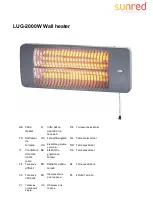
Installation & Operation Manual
6
Multiple tank connections (boiler side)
Multiple tank installations must be done in the “reverse-return”
manner. The reason for this is to create the same pressure drop
(and therefore, the same flow) through the coil of each tank.
The boiler manifold piping must be sized so that each coil has
the flow rate called for in Table 3B.
Because the pressure drop through tank coils varies from size
to size, it is hard to predict the flow rate that will be developed
through each coil when two tanks of different sizes are placed in
the same manifold. For this reason it is best not to mix tanks of
different sizes in the same zone if their recovery is critical.
Table 3B
Pressure Drop Values
MODEL
WATER
INLET
(NPT)
WATER
OUTLET
(NPT)
COIL
CONNECTION
(NPT)
COIL
LENGTH
(FT)
SQ FT
SURFACE
AREA
PRESSURE DROP
(FT/HD)
5
GPM
8
GPM
12
GPM
16
GPM
20
GPM
SIT030
1
1
1
24
8.0
.36
.91
2.06
3.66
5.71
SIT040
1
1
1
30.8
10.0
.41
1.04
2.34
4.16
6.49
SIT050
1
1
1
36.5
12.0
.46
1.18
2.67
4.74
7.4
SIT065
1.5
1.5
1
41.5
13.5
.61
1.57
3.53
6.27
9.8
SIT080
1.5
1.5
1
41.5
13.5
.61
1.57
3.53
6.27
9.8
SIT119
1.5
1.5
1
67.3
22.0
.73
1.87
4.22
7.5
11.71
3
Boiler side piping
Figures 3-1 thru 3-4 show typical boiler side piping for
several common situations. Regardless of which system is
used it is imperative that the flow rates called for in Table
3B are developed through the coil. This requires properly
sized piping and a properly sized pump.
The system shown in FIG’s 3-1 thru 3-4 are described
below:
Zone with circulator to Aquastat
This system is like the circulator zone system on a straight
heat job except that one of the zones goes to the tank
instead of radiation. As on any circulator zone system
check valves should be installed in each zone to prevent
unwanted circulation through zones which are not calling
for heat. Figure 3-1 on page 7 illustrates typical circulator
zone piping.
Zone with valve to Aquastat
As with the circulator zone system, this system is just like a
standard heating zone system except that one of the zones
is connected to the tank coil as shown in FIG. 3-2. The
system circulator must be large enough to move boiler
water through the coil regardless of the flow rate required
through the heating zones.
DHW prioritization
This piping system is designed to provide direct hot
water priority over the other zones in the heating system.
When there is a Domestic Hot Water (DHW) call for
heat, the Knight control will shut off the boiler circulator
and activate the domestic hot water circulator. Once the
DHW demand is satisfied, the boiler circulator will be
readjusted as demand requires. The circulator must be
large enough to move the boiler water through the coils.
The recommended piping for a DHW priority system is
depicted in FIG. 3-3 on page 9.
Table 3A
Pressure Drop Chart
SIT119,
12.00
SIT030 - 119 FRICTION LOSS
SIT030
SIT040
SIT050
SIT065
&
080,
SIT119,
0.00
2.00
4.00
6.00
8.00
10.00
12.00
5
8
12
16
20
FO
O
T
HE
A
D
SIT030 - 119 FRICTION LOSS
GPM







































